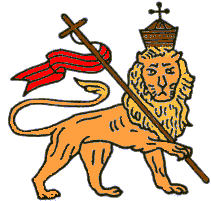T h e N e w G i d e o n F o r c e
T h e P l a n
T h e P l a n
T h e P l a n
A Driving Force
photo caption
Colonel Sandford. Like Wingate he felt committed to freeing Ethiopia and restoring Selassie. Before the war he had spent much time in Ethiopia and at times advised the Emperor.
Photo courtesy of the Imperial War Museum, London
photo caption
Wingate, the Emperor & his close party. In his memoirs Selassie wrote, "They [Wingate and Sandford, and a few others] deserve our accolades for their commitment to truth and justice."20
Photograph courtesy of
Her Majesty's Stationary
Office, London
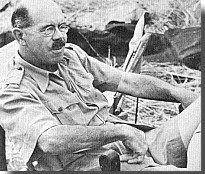
Akin to a whirlwind Wingate descended upon the British command in Sudan. When he arrived he had expressed his confidence to Wavell in the mission if it was approached in the right way. Wingate told Wavell that it was, "vital to support Haile Selassie 100% and that the revolt could be made the vital factor in the coming campaign."1 Wingate met with Emperor Selassie frequently. The first time they met he pledged his loyalty and support for the cause of liberation, assuring him he would lead a force to return him to his throne. In return, he received Selassie's respect & trust. Determined to see the coming field of battle, on November 20 flew on a daring flight inside Ethiopia to meet with Sandford in the Gojjam at a Mission 101 base. The two easily agreed the Emperor should enter Gojjam as soon as possible. This was decided upon for he was seen as a symbol of Ethiopia's lost independence & national unity. Disappointed at the lack of aid given to the Ethiopian revolt, promoted to the temporary rank Lieutenant-Colonel, he set about changing things immediately.
He expanded the mission from a holding action to one of liberation, from harassing to defeating the Italians in the northwest. He dismissed Sandford's plan of waging a guerilla war with distributing money to those Ethiopian tribal leaders who promised to fight Italians as disrespectful and inefficient. As he wrote, "First we have to convince the Ethiopian that contrary to his previous experience, these white men with whom he has to treat will give him a fair deal. He must see us first not fighting by his side, but in front of him...Example instead of precept is what we want."3 He believed a guerilla force hoping to raise revolt must demonstrate strength and appeal to the better side of human nature. Wingate envisioned a small but high-quality force, well led and equipped, operating among a population that was either supportive or neutral. This was opposite of Sandford's idea of distributing arms and money to almost anyone. Writing, "To raise a real fighting revolt you must send in a corps d'elite to do exploits and not peddlers of war material and cash. Given a population favorable to penetration, a thousand resolute and well-armed men can paralyze for an indefinite period the operations of a hundred thousand."4
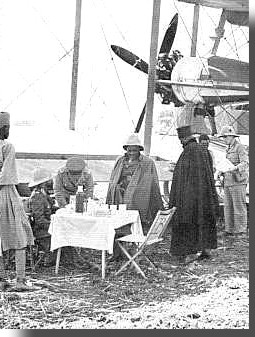 The plan he formulated involved a trained core forming the mobile striking force. They would penetrate into Gojjam, disrupt enemy communications & seize areas in preparation for a drive on the capital, Addis Ababa. In support would be small detachments composed of British cadre, leading small groups of several hundred Patriots. They were to spread guerilla attacks around and in front of the main force creating room for it, and to act as a rallying center. They would be without vehicles to avoid being tied to the few roads, instead using pack animals. In union with local insurgents, their tools would be audacity, bluff, concentrated force, mobility, and surprise.
The plan he formulated involved a trained core forming the mobile striking force. They would penetrate into Gojjam, disrupt enemy communications & seize areas in preparation for a drive on the capital, Addis Ababa. In support would be small detachments composed of British cadre, leading small groups of several hundred Patriots. They were to spread guerilla attacks around and in front of the main force creating room for it, and to act as a rallying center. They would be without vehicles to avoid being tied to the few roads, instead using pack animals. In union with local insurgents, their tools would be audacity, bluff, concentrated force, mobility, and surprise.
He set about devoting his energy to his new task with a crusading zest. To the many of the men who were assigned to serve under him he became inspiring. Hearing of it for the first time, one of the British officers exclaimed it was, "bold and refreshing."5 The famous South African explorer Wilfred Thesiger who was assigned to be Sandford's deputy was inspired by Wingate and the mission. He felt, "Wingate was ruthlessly ambitious, yet his aims transcended personal ambition. He was an idealist and a fanatic. He needed a cause which with he could identify himself, but his intolerance and arrogance required him to be in command. He should have lived in the times of the Crusades. I can picture him in that brutal age, fighting with a mad gleam in his eye to liberate the Holy City, but equally determined, when it fell, to be crowned King of Jerusalem."6
photo caption
A camel supply column for the Patriots winding its way through northwest Ethiopia in early 1941.
Photo courtesy of the Imperial War Museum, London
The Zealous Crusader
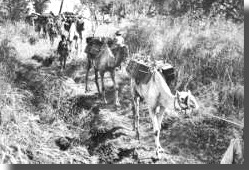
 His arrival on the scene also meant the creation of other enemies besides the Italians. To General Platt who was the military commander in Sudan, Wingate's determination and belligerence spelled trouble. Platt opposed the Emperor's presence, did not think highly of unconventional warfare, nor of the fact he had high backing for such a scheme, and did not like Wingate and his methods. Wingate recognized this, an indifferent attitude and resistance mirrored in the staff and their level of providing support for his preparations. He was also critical of the preparations to aid the Patriots before he arrived and blamed Platt writing, "To sum up its is fair to say that the conduct of the revolt at this stage showed poverty of invention combined with an intention to limit its scope below what was possible and from every point of view desirable."7 And he disliked the relaxed atmosphere in Khartoum.
His arrival on the scene also meant the creation of other enemies besides the Italians. To General Platt who was the military commander in Sudan, Wingate's determination and belligerence spelled trouble. Platt opposed the Emperor's presence, did not think highly of unconventional warfare, nor of the fact he had high backing for such a scheme, and did not like Wingate and his methods. Wingate recognized this, an indifferent attitude and resistance mirrored in the staff and their level of providing support for his preparations. He was also critical of the preparations to aid the Patriots before he arrived and blamed Platt writing, "To sum up its is fair to say that the conduct of the revolt at this stage showed poverty of invention combined with an intention to limit its scope below what was possible and from every point of view desirable."7 And he disliked the relaxed atmosphere in Khartoum.
So Wingate pushed without bothering for proper decorum and respect anyone in authority to get the proper supplies and manpower for the nucleus of the new force. To command staff officers, angry at the lack of support he was getting for his efforts Wingate would be abrupt and openly rude. Combined with his appearance, his mere presence became provoking and unpleasant, and he became seen by many as, "scruffy, uncouth, unsoldierly eccentric."8 One of his fellow MI(R) officers in Khartoum handling supplies and organization was Major Dodds-Parker. He saw how his contrariness could be disruptive. There were moments when the Wingate & Platt declared they would not speak to one another again. Dodds-Parker, would be sent for and told, "The General and Wingate have had another row. Both have resigned. You must bring Wingate back to work this afternoon."10 Thesiger overheard Platt exclaim once, "The curse of this war is Lawrence in the last."11
Wingate at this time still had the cause of Jewish independence and a Jewish army on his mind. He had his faithful Jewish interpreter and friend from his SNS days, Avraham Akavia, flown in to be his personal assistant and aide. He said to Akavia, "Everyone who is a friend of Abyssinia is at the same time a friend of the Jews."12 He believed if he could be a success here, he could be of greater help to the Jews later on, perhaps by leading a Jewish striking force in the war (Others were to come as well, doctors to serve with Gideon Force at his request later during the campaign). To his deep distress, per Wavell’s orders, Wingate was informed that he was forbidden to travel to Palestine under any circumstances. This fueled an anger and bitterness in him, creating a frame of mind described as a, "bloody mindedness."13 Rudeness and deliberate baiting of others were manifestations of his devoting his total energy to his mission to deal with this frustration, this single-mindedness also adding to his tribulations. Still, he asked Wilfred Thesiger once if the he was happy. After hearing his affirmative reply, Wingate reflected and said, "I'm not happy, but I don't think any great man ever is."14
photo caption
Wingate with Emperor Selassie planning for the mission. When word spread of Wingate's visit among the locals during his November trip, it became seen as a religious sign of the return of the Emperor.
Photo courtesy of the Imperial War Museum, London
Molding the Force
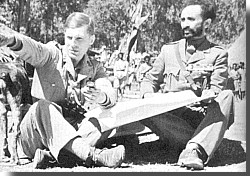
 Along with his small staff and large funding, credit for one million pounds in Maria Theresa silver coins from MI(R), Wingate set about creating the force to help in the liberation of Ethiopia. Weapons arrived at his makeshift camp outside Khartoum and 18,000 camels were bought as use as transport for supplies, along with several thousand camel drivers.15 The main unit would comprise two battalions, one each of Sudanese and Ethiopian troops. A regular unit from the Sudan Defense Force was picked. The battalion (led by Lt.Col Boustead) was made up of mainly experienced Arab Sudanese staffed by professional British & Sudanese officers and NCOs. The other was the smaller 2nd Ethiopian Battalion (led by Major Boyle) already forming, a newly formed unit of volunteers of Ethiopian refugees. Their officers were a mixture of inexperienced British and veteran Ethiopians, the enlisted men all being former soldiers in Haile Selassie's army.
Along with his small staff and large funding, credit for one million pounds in Maria Theresa silver coins from MI(R), Wingate set about creating the force to help in the liberation of Ethiopia. Weapons arrived at his makeshift camp outside Khartoum and 18,000 camels were bought as use as transport for supplies, along with several thousand camel drivers.15 The main unit would comprise two battalions, one each of Sudanese and Ethiopian troops. A regular unit from the Sudan Defense Force was picked. The battalion (led by Lt.Col Boustead) was made up of mainly experienced Arab Sudanese staffed by professional British & Sudanese officers and NCOs. The other was the smaller 2nd Ethiopian Battalion (led by Major Boyle) already forming, a newly formed unit of volunteers of Ethiopian refugees. Their officers were a mixture of inexperienced British and veteran Ethiopians, the enlisted men all being former soldiers in Haile Selassie's army.
Undertaking guerilla warfare & training Patriot rebels would be a half-dozen Operational Centers (10 originally planned). Leading each of these detachments would be 1 officer with 5 British or Commonwealth NCOs who had volunteered, many from garrison duties in Palestine. The detachments were to start out with 80-200 Ethiopians selected from among those in the Sudan with 200 rounds of ammunition each.16 All told the force numbered close to 1,700.17 The heaviest support the force would have was a single mortar platoon. And there was little in the way of communications to outside forces, or medical support. Accompanying them was a propaganda unit already spreading word of the Emperor's encouragement to fight on or switch allegiance from the Italians.
photo caption
Italian colonial levies. The majority of Italian army forces in East Africa were either Ethiopian or Eritrean soldiers. Supporting the regular battalions available were thousands of local tribesmen recruited as part-time irregulars.
Photograph courtesy of
Her Majesty's Stationary
Office, London
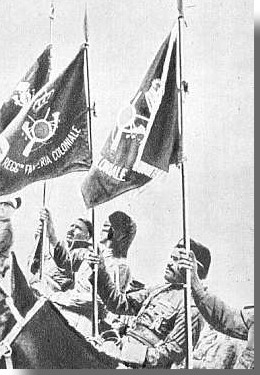 The Italians were aware of the British support for the Patriots & of Selassie's arrival. Immediate Italian forces facing Wingate numbered 15,000 men in 13 colonial & 3 Italian battalions.18 They were backed by light artillery & armored cars. They controlled the northwest Gojjam area from a series of forts along the main northwest-southeast road. The Italians made an effort to politically weaken the resistance & split it. They appointed Ethiopian noble Ras Hailu to an official position, and gave him a salary & weapons to form his own irregular unit. Hailu was an old rival of Selassie’s, having been the former governor and prince of Gojjam before the Italian invasion. This had some effect as a few minor chieftains began to submit.
The Italians were aware of the British support for the Patriots & of Selassie's arrival. Immediate Italian forces facing Wingate numbered 15,000 men in 13 colonial & 3 Italian battalions.18 They were backed by light artillery & armored cars. They controlled the northwest Gojjam area from a series of forts along the main northwest-southeast road. The Italians made an effort to politically weaken the resistance & split it. They appointed Ethiopian noble Ras Hailu to an official position, and gave him a salary & weapons to form his own irregular unit. Hailu was an old rival of Selassie’s, having been the former governor and prince of Gojjam before the Italian invasion. This had some effect as a few minor chieftains began to submit.
photo caption
The January 20th, 1941 flag-raising ceremony at Um Ilda river bed. By now, Wingate had turned his official administrative and liaision duties into an fully operational command.
Photograph courtesy of
the Imperial War
Museum, London
photo caption
A proclamation from General Platt is read out at Um Ilda. The answer-
ing roar of a lion in the bush nearby to a passing aircraft was taken to be a good portent.
Photograph courtesy of
the Imperial War
Museum, London
Preparations Complete
By January of 1941 the British forces under Wavell were concentrating for the offense. A December conference in Cairo had finalized the details for the offense into Italian East Africa. Then London learned from intelligence (cryptology) sources of the upcoming German invasion of the Balkans. Wavell’s successful offense against the Italians in the Western Desert in North Africa, complimented by the passive Italian efforts in East Africa, was demonstrating that Italian fighting power was weaker than initially feared. So the decision was made to free up British troops for the defense of Greece. This meant halting the offense in North Africa, and speeding up the planned one in East Africa in order to bring about its quicker ending. The northern pincer of the offense was reinforced from one to two divisions, and ordered to push the Italians out of all of Eritrea. The southern pincer’s timetable to conquer Somalia was pushed up from May to February. Then the two forces would converge on Addis Ababa and the mountains around Amba Alga in the nation’s center. It was agreed the Patriot revolt would play a major part, and the Emperor’s planned return to Ethiopia was also hastened.
At the December war conference, Wingate was allowed to speak before the top senior officers. He repeated confidence, predicting victory by the end of spring, 1941. While speaking of his plans to weaken the Italians from within, he emphasized the moral aspect of his mission. "Courage, faith, and self-respect, these were the qualities we could appeal to successfully because they were on our side. We had first to convince the Ethiopian...of our bona fidas...he must see us fighting not by his side but in front of him...devoted to the cause of his liberties."19 He saw the revolt and his force with a David and Goliath theme, and along this line Wingate christened his mixed unit Gideon Force. Familiar with guerilla warfare and the Bible, he found the Biblical story of Gideon with his small band of men defeating the larger Midianite force appropriate. So he christened the force Gideon Force.
In January of 1941 the British forces under Wavell were concentrating for the offense. On January 19th the northern part of the offense began as General Platt's 2 Indian divisions pushed forward and engaged the Italians in Eritrea. Five days later, from out of Kenya the southern force of 2 divisions under General Cunningham attacked into Italian Somalia.
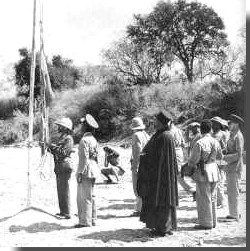 Wingate began pushing out more supply columns and getting several Patriot leaders back into the field. Patriot forces aided by Mission 101 in the Gojjam and elsewhere were forcing the Italians to commit troops, ensuring that such forces would unable to be deployed against the Allied forces to the north and south. Italian troop and supply columns movements were ambushed and disrupted, and a few garrisons were put under siege. This was creating some freedom of movement for any penetrating force into northwest Ethiopia to exploit.
Wingate began pushing out more supply columns and getting several Patriot leaders back into the field. Patriot forces aided by Mission 101 in the Gojjam and elsewhere were forcing the Italians to commit troops, ensuring that such forces would unable to be deployed against the Allied forces to the north and south. Italian troop and supply columns movements were ambushed and disrupted, and a few garrisons were put under siege. This was creating some freedom of movement for any penetrating force into northwest Ethiopia to exploit.
The Wingate’s forces began moving forward in late December and January. With 15,000 camels and horses, the main force of two battalions along with the 2 ready Operational Centers departed in several groups from their forward base in southern Sudan. They were heading for Mount Belaiya inside Ethiopia. Previously reconnoitered, it would serve as the first forward operating base and starting point for the Emperor’s return. Behind the advance, a small engineering force would attempt the building of a road into Ethiopia for future supply movements. On January 20
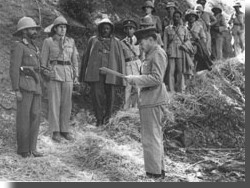
at the little Ethiopian border town of Um Idla, Wingate & elements of the Ethiopian battalion greeted the Emperor as he arrived by plane. With an Ethiopian honor guard presenting arms and flying colors of the Imperial Standard, a formal address was read out from General Platt. Gideon Force led by Wingate was opening up their wing of the British offense.
1. Trevor Royle, Orde Wingate
(London: Weidenfeld & Nicolson, 1995), 176.
2. Christopher Sykes, Orde Wingate
(New York: World Publishing Company, 1959), 245.
3. Wilfred Burchett, Wingate's Phantom Army
(London: Frederick Muller, 1946), 48-9.
4. David Shirreff, Bare Feet And Bandoliers (London: Radcliffe Press, 1995), 14.
5. Shirreff, 58.
6. Wilfred Thesiger, The Life of My Choice (London: Collins, 1987), 350-51.
7. Royle, 179.
8. SDF officer quoted in quoted in Ibid, 187.
9. Douglas Dodds-Parker Setting Europe Ablaze (London: Springwood, 1983), 60.
10. Dodds-Parker, 70.
11. Thesiger, 320.
12. Akavia in Israel Defense Force, Haganah Museum documents 80-69-7.
13. Derek Tulloch, Wingate In War And Peace (London: History Book Club, 1972), 49.
14. Thesiger, 333.
15. Shirreff, 67.
16. Dodds-Parker, 57.
17. Sherriff, 65-7.
18. There were also nearly 10,000 irregulars available at times. Ibid, 40.
19. Sykes, 251-52.
20. Emperor Haile Selassie (Edited by Edward Ullendorff), My Life And Ethiopia's Progress, Vol.II (East Lansing: Michigan State U Press, 1994), 131.
